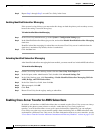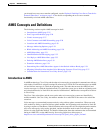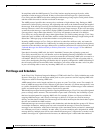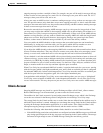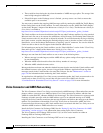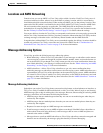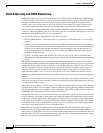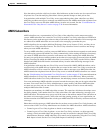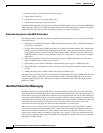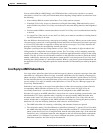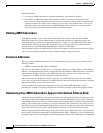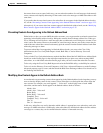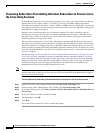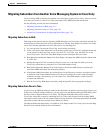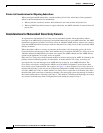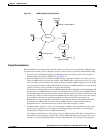
5-32
Networking Guide for Cisco Unity Release 5.x (With Microsoft Exchange)
OL-13844-01
Chapter 5 AMIS Networking
AMIS Concepts and Definitions
• Cannot use the Cisco Unity Inbox to check messages.
• Cannot own private lists.
• Cannot set up or receive message notifications.
• Cannot receive message waiting indications.
Setting up AMIS subscribers requires more overhead for administrators of Cisco Unity than AMIS blind
addressing does. However, the AMIS subscriber option allows other subscribers to address messages to
AMIS subscribers the same way that they address messages to regular subscribers.
Subscriber Experience with AMIS Subscribers
Provided that AMIS subscribers are listed in the phone directory and have had voice names and greetings
recorded for them:
• Subscribers can address messages to AMIS subscribers by using the phone, ViewMail for Outlook,
or the Cisco
Unity Inbox.
• Contacts that correspond to AMIS subscribers are included in Exchange address lists, which means
that they are listed in the Outlook address book (unless the contact has been explicitly prevented
from appearing there) and the Cisco
Unity Inbox address book. Therefore, message addressing to
AMIS subscribers—either by using Outlook or the Cisco
Unity Inbox—is the same as for regular
subscribers.
• When using the phone, subscribers can address messages to AMIS subscribers in spelled-name
mode (if enabled on the system) or by extension.
• Subscribers get voice name confirmation when addressing a message to a AMIS subscriber.
• When subscribers use the phone to listen to messages, the conversation announces who the message
is from.
• AMIS subscribers can be added to public and private distribution lists.
Note that when Cisco Unity records a message from an unidentified caller for an AMIS subscriber, the
Dial ID of the primary location is used as the sending mailbox. Although AMIS subscribers are not
prevented from replying to these messages, the replies are returned to the Unity Messaging System
mailbox as NDRs.
Identified Subscriber Messaging
Identified subscriber messaging (ISM) affects what subscribers hear when they call other subscribers
from their primary or alternate extensions and are forwarded to the greetings of the subscribers they call.
If they then leave a message, ISM affects what the called subscriber hears and can do when listening to
the message. When ISM is enabled, Cisco
Unity recognizes that the calling extension is associated with
a subscriber and accordingly plays the internal greeting of the called subscriber. Additionally, when the
called subscriber later listens to the message, Cisco
Unity plays the recorded voice name of the
subscriber who left the message and allows the called subscriber to record a reply.
When a call to a Cisco Unity subscriber is forwarded to the subscriber greeting and ISM is enabled,
Cisco
Unity compares the calling number (ANI or caller ID) to the primary and alternate extensions of
subscribers. If a match is found, Cisco
Unity identifies the caller as a subscriber. When Cisco Unity
compares the calling number to extensions, by default, only “regular” Cisco
Unity subscribers on the
local system are included in the comparison. ISM can be expanded to include all Cisco
Unity subscribers
throughout a dialing domain.



